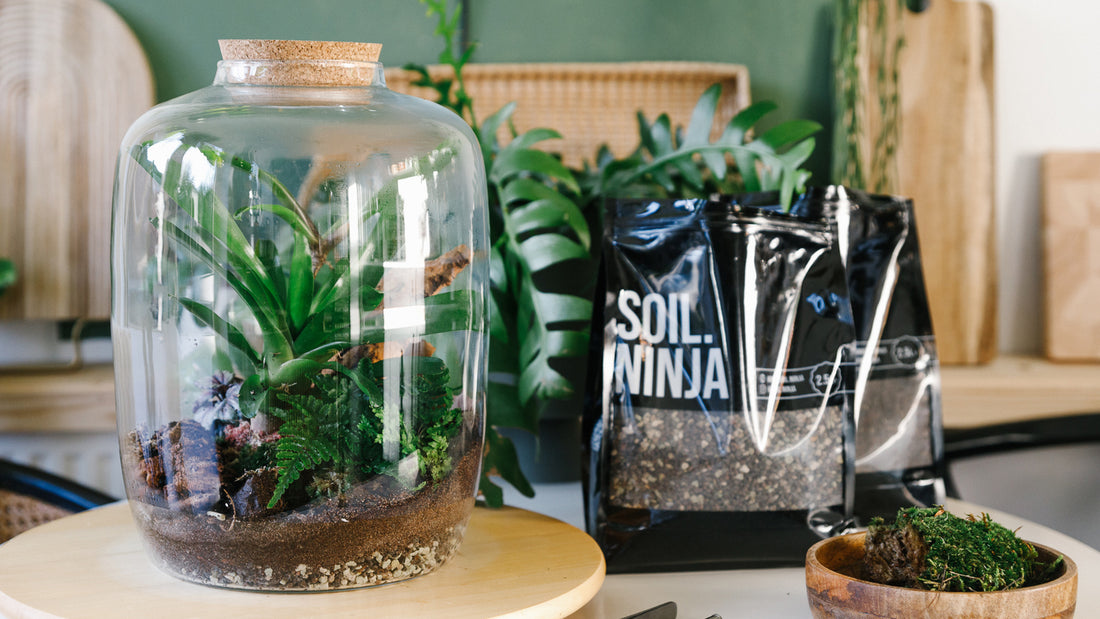Terrariums, often referred to as miniature gardens or ecosystems in a jar, have become a popular way to bring a slice of nature indoors. The choice between an open and a closed terrarium can make a significant difference in the health and growth of the plants inside. In this blog, we will delve into the specifics of open and closed terrariums, and why xeric plants might struggle in a closed environment, while more delicate species like begonias thrive.

Closed Terrariums: A Humid Haven
The closed terrarium is probably the most recognisable terrarium system, this means little to no access to open air and the vast majority of humidity is generated from whatever moisture is present within the system and the plants respiring in it. This is super interesting because we get to watch organisms create their own microclimate that they fuel and maintain! This type of humid environment is ideal for tropical plants, ferns, mosses and sensitive plants that thrive in moist conditions.
Benefits of Closed Terrariums:
- They create a consistent humidity level
- Require less frequent watering
- Ideal for creating a tropical microclimate
When it comes to picking a soil for your closed Terrarium, our Terrarium blend is the one to choose. Don’t forget to use a drainage layer - Using a drainage layer in a terrarium is crucial for preventing water-logging and promoting overall ecosystem health. This setup fosters better air circulation within the substrate, supports healthy root development, and contributes to the well-being of plants and microorganisms in the terrarium. In essence, a drainage layer is essential for maintaining a balanced and thriving terrarium environment.

Open Terrariums: A Breath of Fresh Air
This design allows for greater air circulation and lower humidity levels, making them ideal for plants that thrive in drier conditions, so they are less prone to issues like mould growth. Open Terrariums are usually more stylised for aesthetics but they don't have the same luxury climate making of a closed system, instead they still require manual watering (although it's a bit different to normal pots and planters). But the moisture available remains in the drainage layer for plants that are maybe a little more sensitive to drying out in typical planters.
Benefits of Open Terrariums:
- Better suited for plants like Succulents and cacti (making sure you use a decent amount of drainage).
- Better Ventilation. Airflow prevents excess humidity and mould.
- Easy access for maintenance - Pruning and watering
When choosing a blend for an open terrarium, keep the plants you are using in mind. Lets say you are planting up a few Cacti and Succulents - we would recommend using our Cacti and Succulent soil mix and make sure to implement enough drainage, along with a drainage layer. Clay pebbles make a fantastic drainage layer, or even our Semi-hydro mix if you have that to hand.
Let's Delve Deeper into Terrariums
Most tropical plants will never be as happy as it is in a closed system with high humidity. Many of our beloved aroids like Philodendron, Anthurium and Monstera adore these conditions, BUT it's a doubled edged sword as though the usual species we encounter love these conditions they can quickly outgrow them and become a very egregious terrarium guest. Instead we tend to seek out smaller, more diminutive species of plants or even dwarf species within the aroid family! This can include such absolute bangers as; Philodendron Burle Marx fantasy, Philodendron Sodiroi, Anthurium Radicans, Anthurium Lutheri, Philodendron sp. 'Mini Santiago'. Or aside from aroids you can dive into the incredible world of strange Melastomes like; Triolena, micro Peperomia like P. Emarginella and P. Jamesoniana - and even strange but awesome shinglers like Marcgravia and Rhaphidophora. There are many other vastly interesting but wholly undersized plants that would thrive in a close environment.
When it comes to an open terrarium, these have a different set of rules as mentioned above, but you still have a grand selection of plants that can be grown in them, especially with a generous and well monitored drainage layer. A popular choice for creating a more tropical feel in an open terrarium is planting up some smaller Dracaena (ex. sansevieria) species, they certainly do not require frequent water at the best of times but the many dwarf varieties are a quick and easy way to create a stunning and unobstructed tropical scape in an open terrarium.
The final options for an open set up comes with some harder rules; Xeric plants like cacti and succulents look absolutely incredible in a sand topped open terrarium but in most cases they very quickly rot because they were not set up with a generous drainage layer and their substrate is usually peat based, for a chance at this set up working there needs to be far more aggregate in the substrate (pumice, perlite, zeolite, charcoal etc) so that water can freely move up and down in constant contact with the air to avoid stagnant moisture from rotting those super fine roots! Another hard rule is extraordinarily intense light! You need to blast those plants with the most intense southern exposure you have to keep their immune systems functioning and for them to grow in a consistent and healthy way.
B-B-B-BONUS ROUND!
Another fantastic use for open terrariums is to treat them like a super fancy orchid pot! Planting you common Phalaenopsis in them with just a heap of delightful orchid bark is a fantastic way to display the big floppy leaves and bright green to shimmering silver of their photosynthetic roots!
Not your thing? Why not try building a mini bog in a closed terrarium, this involves playing with some incredibly interesting carnivorous plants that are often for sale, but this drainage layer has to always be full of water and not tap water instead it must be collected rain or RODI water to maintain the zero nutrient and very low pH environments these plants need to grow. That faff truly becomes worth it when you see Dosera and Pinguicula growing and catching flies all day or seeing Utricularia snatching little organisms in the substrate and water with their predatory bladder cells!
In Summary:
Choosing the right type of terrarium is crucial for the health of your plants. Open terrariums offer a dry, airy environment, better suited for plants that don’t appreciate as much humidity, whilst closed terrariums create a humid, stable environment ideal for tropical plants and sensitive plants. Understanding the needs of your plants is key to creating a thriving terrarium ecosystem. So grab your empty jam jar, give it a wash and set up your own ecosystem.

